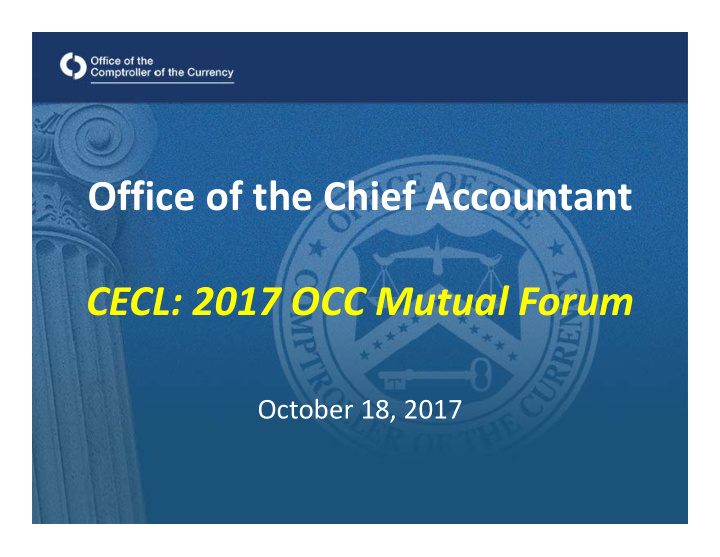



Office of the Chief Accountant CECL: 2017 OCC Mutual Forum October 18, 2017
Frequently Asked Questions https://www.occ.treas.gov/news-issuances/bulletins/2016/bulletin-2016-45.html 2
Frequently Asked Questions 22. What should institutions do to prepare for the implementation of CECL? [December 2016] To plan and prepare for the transition to and implementation of the new accounting standard, each institution is encouraged to: • Become familiar with the new accounting standard and educate the board of directors and appropriate institution staff about CECL and how it differs from the incurred loss methodology; • Determine the applicable effective date of the standard based on the PBE criteria in U.S. GAAP; • Determine the steps and timing needed to implement the new accounting standard; • Identify the functional areas within the institution that should participate in the implementation of the new standard; • Discuss the new accounting standard with the board of directors, audit committee, industry peers, external auditors, and supervisory agencies to determine how to best implement the new standard in a manner appropriate for the institution’s size • Review existing allowance and credit risk management practices to identify processes that can be leveraged when applying the new standard; • Determine the allowance estimation method or methods to be used; • Identify currently available data that should be maintained and consider whether any additional data may need to be collected or maintained to implement CECL. Examples of types of data that may be needed to implement CECL include: origination and maturity dates, origination par amount, initial and subsequent charge ‐ off amounts and dates, and recovery amounts and dates by loan; and cumulative loss amounts for loans with similar risk characteristics; • Identify necessary system changes to implement the new accounting standard consistent with the new standard’s requirements and the allowance estimation method or methods to be used; and • Evaluate and plan for the potential impact of the new accounting standard on regulatory capital. 3
CECL: Effective Dates Entity U.S. GAAP Call Report Type Effective Date Effective Date* Q1 2020 Public Business Fiscal years beginning after 15 December 2019, including (31 March 2020) Entities (PBEs) that interim periods within those fiscal years are SEC Filers Q1 2021 Other PBEs** Fiscal years beginning after 15 December 2020, including (31 March 2021) (Non-SEC Filers) interim periods within those fiscal years Q4 2021 Non-PBEs Fiscal years beginning after 15 December 2020, including (31 Dec 2021) interim periods beginning after 15 December 2021 Permissible Early Application Early application permitted for fiscal years beginning after no earlier than 15 December 2018, including interim periods within those 31 March 2019 fiscal years * For institutions with calendar year ends. 4
CECL Decision Tree 5
6
CECL: Implementation 1. SEC Filers Create Refine roadmap Build Validate & monitor Required Q1 2020 Early 2016 2017 2018 2019 2020 2021 2022 2. Non-SEC Filing Public Business Entities Create Refine roadmap & monitor Build Validate Required Q1 2021 Early 2016 2017 2018 2019 2020 2021 2022 3. All Other Entities Create Refine roadmap & monitor Build Validate Required Q4 2021 Early 2016 2017 2018 2019 2020 2021 2022 7
CECL: Implementation Create Refine & Build Validate monitor Roadmap Create Roadmap • Become familiar with final standard • Establish cross ‐ functional implementation team • Develop implementation plan and timeline • Discuss plan with Board, external auditor, peers, and regulators • Review current allowance and credit risk management practices to identify processes that can be leveraged • Determine the allowance estimate method (or methods) to be used • Consider data availability and needs 8
CECL: Implementation Create Refine & Build Validate monitor Roadmap Data Considerations • Identify currently available data that should be maintained • Stop over-writing data that may be useful in measuring credit quality over the life of the loan (i.e. risk grades, past due status, etc.) • Perform a data gap analysis • Determine how/when to begin collecting additional data, if needed • Establish controls over the completeness and accuracy of this data 9
CECL: Implementation Create Refine & Build Validate monitor Roadmap Data Considerations Examples of types of data that may be needed to implement CECL include Loan-level • origination and maturity dates • origination par amount • initial and subsequent charge-off amounts and dates • recovery amounts and dates • renewal or modification dates Cumulative loss amounts for loans with similar risk characteristics 10
CECL: Implementation Create Refine & Validate Build monitor Roadmap Build • Evaluate quantity and quality of historical data • Address any needed data ‐ archiving improvements and/or system changes • Build or update methodologies • Address accounting policy questions • Consider information needed for disclosure requirements (if applicable) • Plan for the potential impact on capital • Present projected impact on earnings and capital to the board and senior management • Develop process documentation and establish controls 11
CECL: Implementation Create Refine & Build Validate monitor Roadmap Validate Refine & monitor • Consider parallel run and adjust • Assess accuracy of method/model method/model as needed and refine inputs and approach as necessary • Test the control environment for new methods/models • Continue to provide the Board and senior management with updates • Update projected impact on on reserve levels and any changes earnings & capital and consider to models/ processes disclosure requirements • Respond to any concerns raised by • Review instructional and form external auditors and/or regulators changes for call reports 12
CECL Questions? Please send them to: CECL@occ.treas.gov 13
Recommend
More recommend